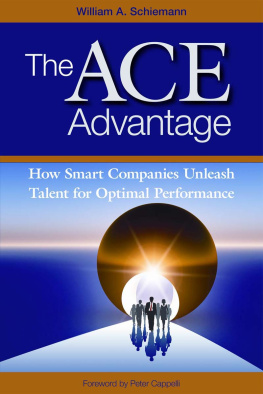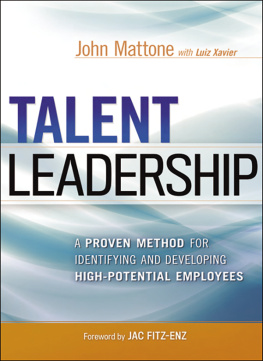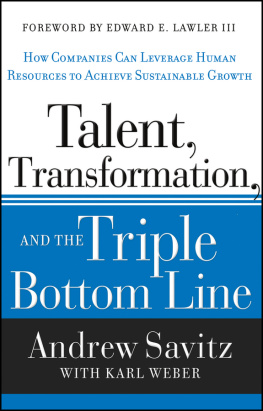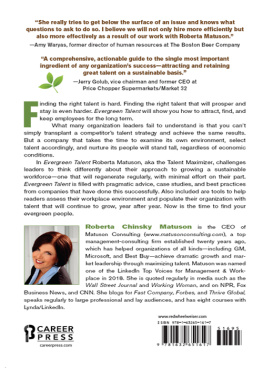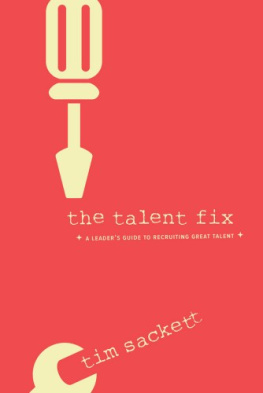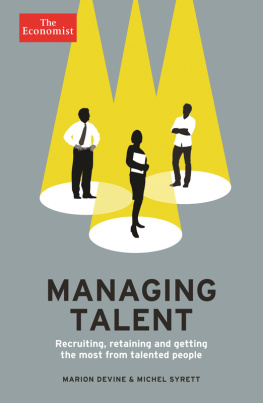
This publication is designed to provide accurate and authoritative information regarding the subject matter covered. It is sold with the understanding that neither the publisher nor the author is engaged in rendering legal or other professional service. If legal advice or other expert assistance is required, the services of a competent, licensed professional should be sought. The federal and state laws discussed in this book are subject to frequent revision and interpretation by amendments or judicial revisions that may significantly affect employer or employee rights and obligations. Readers are encouraged to seek legal counsel regarding specific policies and practices in their organizations.
This book is published by the Society for Human Resource Management (SHRM). The interpretations, conclusions, and recommendations in this book are those of the authors and do not necessarily represent those of the publisher.
Copyright 2012 Metrus Group. All rights reserved.
This publication may not be reproduced, stored in a retrieval system, or transmitted in whole or in part, in any form or by any means, electronic, mechanical, photocopying, recording, or otherwise, without the prior written permission of the Society for Human Resource Management, 1800 Duke Street, Alexandria, VA 22314.
The Society for Human Resource Management (SHRM) is the worlds largest association devoted to human resource management. Representing more than 250,000 members in over 140 countries, the Society serves the needs of HR professionals and advances the interests of the HR profession. Founded in 1948, SHRM has more than 575 affiliated chapters within the United States and subsidiary offices in China and India. Visit SHRM Online at www.shrm.org.
Interior and Cover Design: Shirley E.M. Raybuck
Library of Congress Cataloging-in-Publication Data
Schiemann, William.
The ACE advantage : how smart companies unleash talent for optimal performance / William A. Schiemann. -- 1st ed.
p. cm.
Includes bibliographical references and index.
ISBN 978-1-58644-270-5
1. Personnel management. 2. Ability. 3. Performance. I. Title.
HF5549.S2234 2012
658.314--dc23
2012001592
Contents
Foreword
In the broad sweep of business history, the topic of human resources has risen and fallen in importance. Problems associated with employees rise up, more attention is paid to solving those problems, and once we figure out how to address them, they decline again in importance.
The period following the early 1980s saw a decline in concerns associated with human resources. Especially in the U.S., unions lost power, relatively lean economic times meant hiring was less of a concern, and downsizing created a supply of talent on the outside market that made it easy to hire for whatever skill needs employers had. The traditional model of internal development of talent, picking candidates in advance and developing them for future jobs, seemed to work fine for those employers whose needs were unique to them or who otherwise were inclined to grow from within.
This relatively benign period has begun to recede, however. One reason is that enough employers have backed away from developing their own talent so that, particularly for management jobs, the pool of qualified candidates who can step in from outside to fill vacancies elsewhere is now very limited. Another factor is the rapid change in business strategies and associated restructuring that has made it difficult to rely on established practices and procedures to run operations. Instead, managers and executives must step in and create new ways of getting work done more or less on the fly. Finally, employers are becoming increasingly aware of the varying contributions that individuals make in these new working arrangements: The very best of whom appear to be many times more effective than the average. The one-time increases in performance that came about from longer hours and more effort, especially for white-collar workers, have hit their limits.
This is the context for The ACE Advantage: How Smart Companies Unleash Talent for Optimal Performance. Bill Schiemann documents prominent cases from around the globe where business plans fail because of shortfalls of skill or abilities. The lost opportunities that come from having a workforce that is not Aligned, Capable, and Engaged the ACE model that Bill advances in the pages that follow become very costly, and the ability to tap this People Equity becomes arguably the biggest source of long-term comparative advantage.
The case that Bill makes for avoiding those problems begins with the notion that one-size-fits-all strategies dont make sense. The historical paradigm on which we managed employees and tried to meet talent needs no longer works because of the challenges raised by this new context above and more fundamentally because becoming effective at managing talent issues requires making choices. The most important choice is to align approaches to people management with the unique business needs and business strategies for competing that every organization has. Into that framework, he mixes the traditional concern about engaging the hearts and minds of employees and developing the competencies the organizations need to meet those unique business challenges.
Fundamental to the books approach is the notion at the heart of all good management, and that is the need to make choices. There are quite often tradeoffs between goals and priorities. Choosing those tradeoffs appropriately, in the context of the specific needs of each organization, is what makes sense.
The idea that human resources is its own world of professional, best practices is surely in decline, especially as we look around the world and see different models succeeding in different ways. The path forward for businesses surely begins by starting with the business imperative, and The ACE Advantage offers the road map to do it.
Peter Cappelli
Professor of Management
Director of Center for Human Resources
The Wharton School
Preface
The writing and research for my last book, Reinventing Talent Management, began during an economic boom and was completed during what has now become known as the Great Recession. We learned a lot about what organizations hold near and dear when the times get tough regarding commitments to employee engagement and leader development, maintaining their employer brands, staying focused on their business and talent strategies, hiring for today versus tomorrow, and so forth.
In contrast, the writing and research for this book began during the Great Recession and ended in the midst of a gyrating marketplace periods of boom and bust for firms in different industries and geographies, high unemployment in a vast number of countries around the globe, a stock market roller coaster, political upheavals in many countries, and increasing financial, environmental, and social sustainability concerns. In short, a period of enormous turbulence! Perhaps this is the new normal.
In many ways, it appears that we are at an inflection point one that will reshape the way organizations compete with each other and people compete for opportunities to grow and prosper. If you are out front of the turbulence, taking command rather than merely reacting, you are likely to be a game changer. If you are behind the curve, then chances are you will be at the mercy of the unrelenting crosscurrents that will determine the nature, direction, and success of your organization. Given all these forces, the use of talent in all forms will play a pivotal role. Because people are the asset most seriously affected by the revolution around us, how well we manage the human side of our organizations will be
Next page
